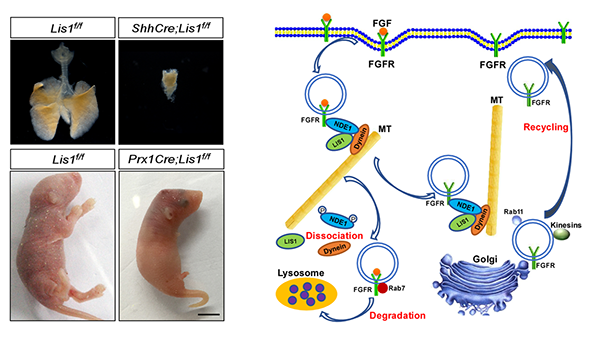On March 20, 2018, Dr. Hai Song’s Laboratory published a research paper entitled “The LIS1/NDE1 Complex Is Essential for FGFSignaling by Regulating FGF Receptor IntracellularTrafficking”. The effect of LIS1/NDE1 complex on mouse embryonic and limb development and its related molecular mechanisms were revealed.
Previous studies on LIS1/NDE1 focused on the process of neural development. LIS1/NDE1 mutations can cause neurodevelopment defects in mice. Similarly, LIS1 defects in the human body can also cause severe neurodevelopmental disease- type 1 lissencephaly. This disease is thought to be due to the failure of neuronal precursor cell division and migration and the loss of motor protein-driven cellular processes. LIS1 interacts directly with dynein, and NDE1/NDEL1 recruits LIS1 to dynein and stabilizes the interaction between dynein and LIS1. In addition, LIS1 is also essential for the efficient transport of cargo mediated by dynein and the correct location of Golgi, endosomes, lysosomes and mitochondria.
Fibroblast growth factor (FGF) signaling plays an important role in embryonic organogenesis. FGFs can bind to four variable cleavage forms of FGF receptors (FGFR1-FGFR4), causing intracellular signaling cascades, this includes the well-known RAS/RAF/ERK and PI3K/AKT signaling pathways.
The intracellular trafficking of membranous organelles and protein complexes is the basis for cellular signaling and cell function. The cytoplasmic dynein and its regulatory proteins LIS1 and NDE1 are important for the transport of various intracellular carriers along the microtubule network. Microtubule-based motility defects are related to developmental disorders. In this study, Dr. Song’s group found that conditional knockout of LIS1 in the developing endoderm of the lung and the mesenchymal cells of the limbs leads to agenesis of the lungs and limbs, and these phenotypes can be partially rescued by activating the oncogene Kras. In these mutants, there is a marked increase in apoptosis and a decrease in the activity of FGF signaling pathways. At the same time, there are defects in FGF signal transduction in LIS1-deleted MEF cells. At the molecular level, LIS1 can regulate FGF receptor localization, protein stability and recycling. It is worth noting that FGFR1 can promote tyrosine phosphorylation of NDE1, resulting in the disassembly of the LIS1/NDE1 complex. Therefore, this study suggests for the first time that the LIS1/NDE1 complex is an important FGF signal regulator, provides new insights into cell signaling, endocytosis transport mechanisms, and genetic diseases associated with LIS1/NDE1 mutations.
Ph.D. students Liu Liansheng and Lu Jinqiu in Dr.Song’s group are co-first authors. Dr. Song is the corresponding author of this article. The study was funded by the National Natural Science Foundation of China, the Thousand Talents Program of the Central Organization Department.

Figure legend. Loss of Lis1 in embryonic lung and limb leads to severe developmental defects of lung and limb. Schematic diagram for the role of Lis1/NDE1/Dynein complex in FGF signaling. Ligand dependent FGFR activation promotes NDE1 phosphorylation which leads to the dissociation of Lis1/NDE1/Dynein complex and degradation of FGFR.
Link:http://www.cell.com/cell-reports/fulltext/S2211-1247(18)30272-9



